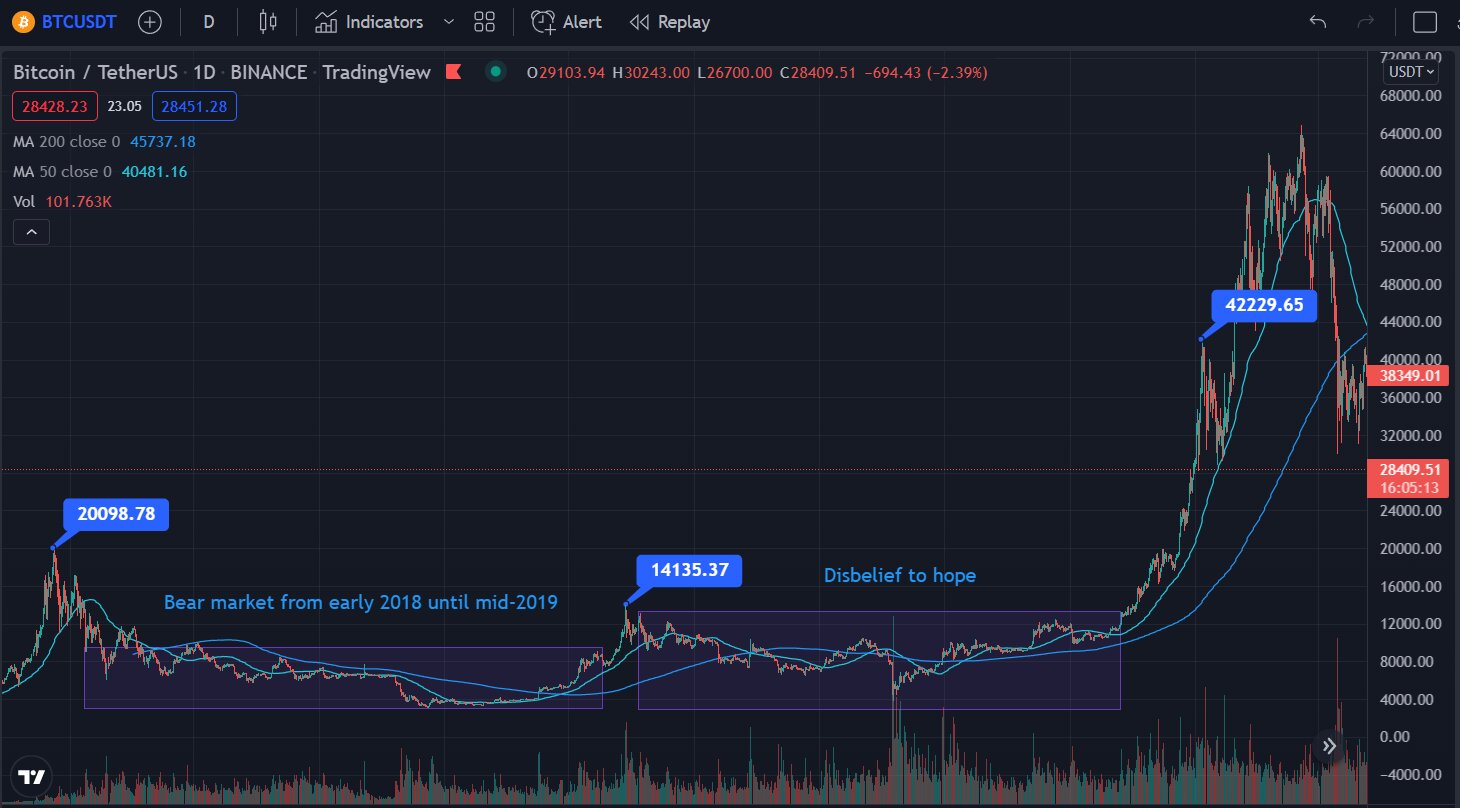Introduction
The cryptocurrency market has experienced significant ups and downs since its inception. One notable period of decline is commonly referred to as “Crypto Winter.” This term describes a prolonged bear market where cryptocurrency prices plummet, investor sentiment turns negative, and the overall market experiences a significant downturn.
During the Crypto Winter, many cryptocurrencies experienced a sharp decline in value, with prices dropping to all-time lows. Bitcoin, the most popular and widely traded cryptocurrency, saw its price fall from an all-time high of nearly $20,000 in late 2017 to less than $4,000 by the end of 2018. This prolonged period of price decline and market uncertainty left investors and enthusiasts wondering when the Crypto Winter would finally come to an end.
While the cryptocurrency market is highly volatile and unpredictable, there are several indicators that suggest the end of the Crypto Winter may be on the horizon. This article will explore the potential signs of recovery and discuss the factors that could contribute to the revival of the cryptocurrency market.
It is important to note that the information provided in this article is not financial advice and should not be construed as such. The cryptocurrency market is highly speculative and carries inherent risks. It is crucial to conduct thorough research and consult with a financial advisor before making any investment decisions.
What is Crypto Winter?
Crypto Winter refers to a period of extended decline in the cryptocurrency market, characterized by a significant drop in prices and a lack of positive investor sentiment. It is analogous to the concept of a bear market in traditional financial markets, where prices decrease and pessimism prevails.
During Crypto Winter, the value of cryptocurrencies experiences a substantial decline, often leading to a loss of investor confidence. This decline can last for months or even years, as was the case during the most severe Crypto Winter in 2018.
The causes of Crypto Winter can vary, but typically stem from a combination of factors such as regulatory changes, market manipulation, lack of adoption, and negative media coverage. The burst of the cryptocurrency bubble in late 2017 contributed to the onset of Crypto Winter, as the rapid rise in prices could not be sustained, leading to a subsequent crash.
One key characteristic of Crypto Winter is the “hodling” mentality, where investors hold onto their cryptocurrencies rather than selling them, hoping that prices will eventually recover. This further exacerbates the decline in trading volume and market activity, contributing to the overall downturn.
During Crypto Winter, the market sentiment is dominated by fear, uncertainty, and doubt (FUD) among investors. FUD can be fueled by negative news, such as security breaches, regulatory crackdowns, or scams within the cryptocurrency ecosystem. This negative sentiment can cause a downward spiral as more investors lose confidence and sell off their holdings, further driving prices down.
Overall, Crypto Winter is a challenging period for cryptocurrency enthusiasts and investors. The market experiences a prolonged downturn, with few opportunities for profitability. However, it is important to remember that market cycles are a natural part of any investment landscape, including cryptocurrencies. While Crypto Winter can be disheartening, it is not the end of the cryptocurrency industry, and there is potential for recovery and growth in the future.
Causes of Crypto Winter
Several factors contribute to the onset and continuation of Crypto Winter in the cryptocurrency market. Understanding these causes can provide insight into the dynamics of the market and help investors navigate through the downturn. Below are some key factors that have played a role:
- Regulatory Uncertainty: One of the primary causes of Crypto Winter is regulatory ambiguity and uncertainty. Governments around the world have been grappling with how to regulate cryptocurrencies and initial coin offerings (ICOs). The lack of clear regulations or conflicting regulations across different jurisdictions creates a sense of uncertainty among market participants, which can dampen investor confidence.
- Market Manipulation: As with any financial market, the cryptocurrency market is also susceptible to manipulation. The presence of market manipulators, commonly known as “whales,” who hold significant amounts of cryptocurrencies, can distort prices and create false market trends. Manipulative practices such as pump-and-dump schemes or coordinated selling can contribute to the downward trajectory of prices during Crypto Winter.
- Lack of Mainstream Adoption: Despite the growing interest in cryptocurrencies, widespread adoption has been slow. The limited use cases and practical applications of cryptocurrencies in everyday life have hindered their mainstream adoption. The lack of real-world utility and consumer acceptance has hampered the growth of the cryptocurrency market, contributing to the prolonged Crypto Winter.
- Security Concerns: The cryptocurrency industry has faced numerous security breaches, hacks, and scams. These incidents erode investor trust and confidence, leading to a more cautious approach to investing in cryptocurrencies. The lack of robust security measures and the prevalence of fraudulent activities have created a negative perception of the market, further contributing to the Crypto Winter.
- Market Speculation: Speculative behavior within the cryptocurrency market has played a significant role in the onset and severity of Crypto Winter. The rapid price increases in 2017 attracted many inexperienced investors who were primarily driven by the fear of missing out (FOMO). When the market corrected, these speculative investors exited the market, causing a downward pressure on prices.
It is worth noting that these causes are not exhaustive, and the cryptocurrency market is influenced by various other factors as well. However, understanding these primary causes helps investors develop a more comprehensive perspective on the dynamics of Crypto Winter and its potential implications.
Signs of Crypto Winter Coming to an End
While the cryptocurrency market has experienced a prolonged period of decline during Crypto Winter, there are several indicators that suggest a potential end to this bearish market. These signs provide hope to investors and enthusiasts, signaling a possible revival of the cryptocurrency market. Here are some key signs to look out for:
- Stabilization of Prices: One of the initial signs of the Crypto Winter coming to an end is the stabilization of cryptocurrency prices. Instead of experiencing extreme volatility and continuous price drops, the market starts to show signs of price consolidation. This stability suggests that the selling pressure is diminishing, and market participants may be regaining confidence.
- Institutional Interest: The involvement of institutional investors in the cryptocurrency market is viewed as a positive sign for its recovery. Institutional investors bring credibility, capital, and a long-term investment approach to the market. Investments from institutional players, such as hedge funds, asset management firms, and pension funds, indicate growing confidence in the future potential of cryptocurrencies.
- Increased Trading Volumes: Another encouraging sign is a significant increase in trading volumes. Higher trading volumes suggest renewed interest and participation in the cryptocurrency market. As trading activity rises, it indicates an increased flow of capital and liquidity, which are vital for the market’s stability and recovery.
- Positive Regulatory Developments: Favorable regulatory developments can have a profound impact on the cryptocurrency market. Clarity and supportive regulations can attract institutional players, mitigate concerns around legal compliance, and reduce market manipulation. Positive regulatory steps, such as government recognition, regulatory frameworks, or the approval of cryptocurrency-based financial products, can signal the potential end of Crypto Winter.
- Technological Advancements: Technological advancements and innovations within the cryptocurrency space can also contribute to the end of the Crypto Winter. Upgrades in scalability, security, and user experience address some of the fundamental challenges faced by cryptocurrencies, making them more attractive and practical for everyday use. Developments like the adoption of blockchain technology by established companies or the emergence of new decentralized applications can rekindle interest and market momentum.
It is important to note that these signs are not definitive guarantees of the end of Crypto Winter. The cryptocurrency market is highly volatile and subject to various factors, both internal and external. Investors should always conduct thorough research and carefully monitor market trends to make informed investment decisions.
The Role of Institutional Investors
The involvement of institutional investors in the cryptocurrency market plays a crucial role in the potential end of Crypto Winter. Institutional investors, such as hedge funds, asset management firms, and pension funds, bring substantial capital, experience, and credibility to the market. Their participation can have a significant impact on market sentiment and provide a catalyst for the revival of the cryptocurrency industry. Here are a few key aspects of the role institutional investors play:
Increased Liquidity and Market Depth
Institutional investors typically bring large amounts of capital into the market, which enhances liquidity and market depth. Their participation can help mitigate the issue of low trading volumes and narrow bid-offer spreads. Increased liquidity makes it easier for investors to enter and exit positions and facilitates more efficient price discovery. As liquidity improves, the market becomes more attractive to other investors, leading to increased market activity and a potential end to Crypto Winter.
Long-Term Investment Perspective
Institutional investors often have a long-term approach to investing, which can bring stability to the cryptocurrency market. Unlike short-term speculative traders, institutional investors focus on fundamental analysis and the long-term viability of assets. Their presence helps dampen extreme price volatility and reduces the influence of short-term market fluctuations. The long-term perspective of institutional investors signals confidence in the industry’s potential and can instill trust among other market participants.
Rigorous Due Diligence and Risk Management
Institutional investors typically conduct thorough due diligence and implement robust risk management practices before investing in cryptocurrencies. Their involvement introduces a higher level of scrutiny and evaluation of potential investments, enhancing overall market integrity. Institutional investors’ in-depth research and risk management processes can help identify quality projects with strong fundamentals, weeding out scams and fraudulent activities. This scrutiny contributes to the maturation of the cryptocurrency market and boosts investor confidence.
Market Validation and Media Attention
The entry of institutional investors into the cryptocurrency market is often seen as a validation of the industry. Their participation generates media attention and brings mainstream visibility to cryptocurrencies. Positive news and coverage from reputable institutions can reshape public perception and dispel negative associations with the asset class. This greater media attention can create a positive feedback loop, attracting more investors and signaling the potential end of Crypto Winter.
While the participation of institutional investors offers great potential for the end of Crypto Winter, it is important to note that their entry into the market is not without risks or challenges. Regulatory uncertainties, custody solutions, and compliance concerns need to be addressed to foster broader institutional adoption. However, as these barriers are gradually overcome, institutional investors are likely to play an increasingly pivotal role in the recovery and growth of the cryptocurrency market.
Regulatory Developments
Regulatory developments and clarity within the cryptocurrency industry have the potential to significantly impact the trajectory of Crypto Winter. As governments and regulatory bodies around the world adapt to the digital asset landscape, their actions can either hinder or foster the growth of cryptocurrencies. Here are some key aspects of regulatory developments and their implications:
Clear Guidelines and Frameworks
One of the most significant regulatory developments that can contribute to the end of Crypto Winter is the establishment of clear guidelines and frameworks for cryptocurrencies. When governments provide explicit regulations, it reduces uncertainty and provides greater clarity for businesses and investors. Clear guidelines can address compliance requirements, know-your-customer (KYC) and anti-money laundering (AML) obligations, and taxation policies. These regulations bring legitimacy to the industry and help build trust among market participants.
Government Recognition and Support
Government recognition and support of cryptocurrencies can accelerate the market’s recovery. When governments acknowledge the potential benefits of digital assets and blockchain technology, it can lead to increased adoption and investment. Governments that offer supportive policies, tax incentives, or promote blockchain research and development foster an environment conducive to the growth of cryptocurrencies. Additionally, the acknowledgment of cryptocurrencies as legal financial instruments can attract more institutional investors and traditional financial institutions into the market.
Preventing Market Manipulation
Regulatory efforts to detect and prevent market manipulation can help restore investor confidence and contribute to the end of Crypto Winter. Regulatory authorities can implement surveillance measures and enforcement mechanisms to identify and prosecute individuals or entities engaging in fraudulent activities or market manipulation. By addressing manipulation and ensuring fair market practices, regulators can help create a more transparent and trustworthy ecosystem for cryptocurrencies.
International Coordination and Cooperation
Given the global nature of cryptocurrencies, international coordination and cooperation among regulatory bodies are essential. Collaborative efforts can harmonize regulations and ensure consistent treatment of cryptocurrencies across different jurisdictions. This coordination can reduce regulatory arbitrage and provide a level playing field for market participants. International cooperation also helps in addressing cross-border issues such as money laundering, terrorist financing, and consumer protection, fostering a more secure and regulated environment for cryptocurrencies.
Investor Protection Measures
Regulatory developments that prioritize investor protection can enhance market confidence and drive the recovery of the cryptocurrency market. Measures such as mandatory disclosures, investor education initiatives, and safeguards against scams and fraudulent activities help protect retail investors. Regulators can also establish licensing requirements for cryptocurrency exchanges and custody providers, ensuring proper security protocols and operational standards. These measures provide greater trust and security for investors, potentially leading to increased participation and market stability.
While regulatory developments play a significant role in the potential end of Crypto Winter, it is important to strike a balance between regulation and innovation. Overly restrictive regulations or stifling innovation may hinder the growth of the industry. As the regulatory landscape evolves, finding the right balance between regulation, consumer protection, and fostering innovation will be crucial for the sustained recovery of the cryptocurrency market.
Market Recovery and Price Predictions
The recovery of the cryptocurrency market from Crypto Winter is a topic of great interest to investors and enthusiasts alike. While predicting the future price movements of cryptocurrencies is inherently challenging, there are several factors that can influence the market’s recovery. Here are some key considerations and price predictions:
Market Cycles and Historical Patterns
Throughout the history of the cryptocurrency market, it has shown cyclical patterns of booms and busts. Each cycle is characterized by periods of rapid price increases, followed by sharp declines and consolidation. Understanding these historical patterns can provide insights into the potential timing and magnitude of market recoveries. However, it is important to note that past performance is not necessarily indicative of future results, and the cryptocurrency market is highly volatile and influenced by numerous factors.
Technological Advancements and Adoption
Technological advancements and increased adoption can contribute to market recovery. As blockchain technology continues to evolve and become more scalable, secure, and user-friendly, it may attract more users and businesses to embrace cryptocurrencies. The wider acceptance and integration of cryptocurrencies in various industries can drive demand and potentially lead to price appreciation. However, widespread adoption may take time, and the pace of technological advancements and adoption will likely vary across different sectors and regions.
Institutional Investments
The entry of institutional investors into the cryptocurrency market has the potential to bring significant capital and credibility. Institutional investments can lead to increased liquidity, stability, and improved market sentiment. The involvement of established financial institutions can also help pave the way for regulatory advancements and provide additional legitimacy to the asset class. While institutional investments can have a positive impact on the market, their timing and magnitude are uncertain, and it is difficult to predict their exact influence on prices.
Market Sentiment and Investor Confidence
Market sentiment and investor confidence play a crucial role in the recovery of any financial market, including cryptocurrencies. Positive news, regulatory developments, and improved public perception can significantly impact market sentiment and drive the recovery of the cryptocurrency market. However, negative news, regulatory hurdles, or security breaches can have the opposite effect and prolong the Crypto Winter. It is important to closely monitor market sentiment and investor confidence indicators to assess the potential for market recovery.
As for price predictions, it is challenging to provide specific figures due to the unpredictable nature of the cryptocurrency market. Price projections are speculative and subject to numerous variables. While some analysts and experts may offer forecasts based on technical analysis, fundamental analysis, or sentiment analysis, it is important to approach such predictions with caution. Awareness of the inherent risks and volatility associated with cryptocurrencies is crucial, and investors should always conduct their own research and consult with financial professionals before making investment decisions.
How to Prepare for the End of Crypto Winter
As the cryptocurrency market shows signs of potential recovery from Crypto Winter, it is essential for investors to prepare themselves for the changing market dynamics. Here are some strategies to consider when preparing for the end of Crypto Winter:
Educate Yourself
Continuing education about cryptocurrencies and blockchain technology is crucial to stay informed and make informed investment decisions. Understand the underlying technology, the projects you are investing in, and the market trends. Stay updated on regulatory developments, technological advancements, and industry news. Engage in communities and forums to exchange ideas and insights with fellow enthusiasts.
Diversify Your Portfolio
Diversification is a fundamental risk management strategy. Instead of focusing solely on one cryptocurrency, consider diversifying your portfolio across different crypto assets. Allocate your investments across various projects, sectors, and geographic regions. Diversification can help mitigate risks associated with the volatility of individual cryptocurrencies and improve your chances of capitalizing on potential market movements.
Invest What You Can Afford to Lose
Cryptocurrencies are highly volatile and carry inherent risks. It is crucial to only invest funds that you can afford to lose without a significant impact on your financial well-being. Set a budget for your cryptocurrency investments and stick to it. Avoid leveraging or taking on excessive debt to invest in cryptocurrencies, as this can amplify risks and financial stress.
Stay Cautious and Do Your Research
Exercise due diligence when considering new investment opportunities and conducting thorough research before making any investment decisions. Assess the team behind a project, evaluate its roadmap and potential for adoption, and scrutinize its tokenomics. Beware of fraudulent schemes, scams, and get-rich-quick promises. Be cautious of investment advice from unreliable sources and always verify information independently.
Consider Dollar-Cost Averaging
Dollar-cost averaging involves investing a fixed amount of money at regular intervals regardless of the cryptocurrency’s price. This strategy helps mitigate the impact of short-term price fluctuations and reduces the risk of investing in an asset at its peak. By consistently investing over time, you can benefit from lower average prices during market downturns.
Set Realistic Expectations
While optimism is essential in investing, it is necessary to set realistic expectations. Understand that market recoveries may take time and might not result in an immediate surge in prices. Crypto Winter may be followed by a prolonged period of consolidation or gradual upward movements. Avoid falling prey to unfounded hype and unrealistic price predictions.
It is important to note that these strategies do not guarantee success or shield against risks. Cryptocurrencies remain highly volatile and speculative assets. Individual circumstances, risk tolerance, and investment goals should always be considered when implementing any investment strategy.
Conclusion
Crypto Winter has been a challenging period for the cryptocurrency market, characterized by a prolonged decline in prices and negative investor sentiment. However, there are several signs that point to a potential end of this bearish phase. The involvement of institutional investors, regulatory developments, technological advancements, and market recovery indicators provide hope for the revival of the cryptocurrency market.
While the recovery of the cryptocurrency market is not guaranteed, investors can take certain steps to prepare themselves. Education, diversification, cautiousness, and realistic expectations are key factors to consider. Staying informed, conducting thorough research, and exercising due diligence are crucial when navigating through the dynamic cryptocurrency landscape.
It is important to remember that investing in cryptocurrencies carries inherent risks, and the market can still be highly volatile. Investors should only allocate funds they can afford to lose and should always consult with financial professionals before making investment decisions. Adapting to market changes, staying informed, and maintaining a long-term perspective can help investors navigate the end of Crypto Winter and position themselves for potential growth in the future.

























